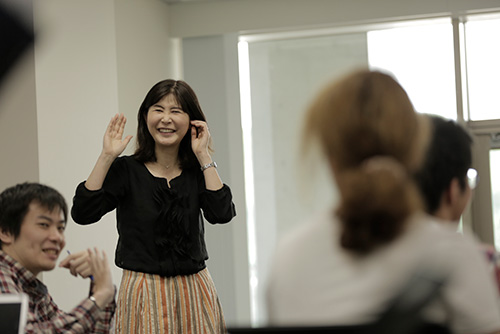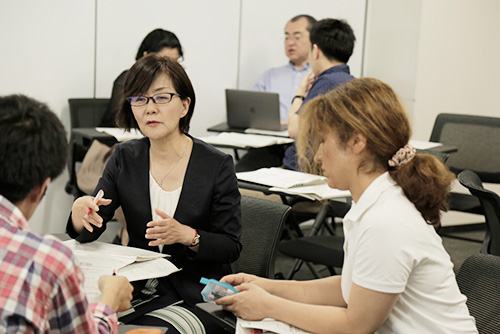What is class design and methods?
Here we explain design and teaching methods in classes, the individual components that make up courses* (at Kyoto University, one course comprises fourteen classes). In recent years, an expectation has arisen that lecture-style courses in particular will be converted into Active Learning formats, so this approach will also be explained below.
* “Courses” are the discrete teaching units of a curriculum. In Japan, in accordance with the Standards for Establishment of Universities, courses are classified into “lecture courses,” “seminar courses,” and “laboratory courses.”
Class Design and Methods
1.1 Strengths and Weaknesses of Lectures

[Strength]
- With skilled lecturing performance, the instructor can draw students in and ignite their interests and passions.
- A large volume of information can be imparted in a short space of time.
- Students can be introduced to knowledge and issues distinct from those in the textbook, as well as new knowledge and scholarly trends not found in the textbook.
- In general, the impact of lectures on students is weaker than for other formats such as Active Learning, but the exception is highly capable students, who sometimes perform at a higher level when lectures are used.
- Active Learning has been found to produce better results when it comes to memory reconstruction (degree of knowledge retention), but there are also findings that suggest this relationship is not always reflected in terms of comprehension. In some cases, better results are achieved through lectures.
[Weakness]
- If the instructor is not a skilled lecturer, students are not attracted and do not follow the lecture with interest.
- In general, Active Learning that incorporates activities (exercises) such as writing, speaking, and presenting is considered more effective in imbedding knowledge. In Active Learning, when students produce outputs and pursue discussions with others, they engage in information processing based on, or accessing, their own world of knowledge in the form of experiences, natural points of view, and the like (known as self-referencing). This involves more complex processing than the act of “listening” in lectures, and as a result, knowledge retention is thought to be easier.
- Lectures do not cultivate capacities for thinking and judgment such as logical, critical and creative thinking and problem-solving skills, essential in the context of the current demands for capacity building. Cultivating these capacities requires Active Learning that involves expression (output) in forms such as writing, speaking, and presenting.
1.2 Class Development Begins with the Syllabus

Taking liberal arts and sciences courses as an example, the syllabus is expected to cover matters including:
- teaching format (lecture, seminar, laboratory, etc.), year level, and eligible students
- course outline and aims
- achievement objectives
- class plans and content
- conditions for taking the course;
- grade evaluation methods/approaches and degrees of achievement
- textbooks
- reference materials
- out-of-class study (preparation/review)
These are the points that constitute the course.
- The points which must be considered firstly when creating a syllabus are (3), (4), and (6) above, based on (2). Points (3), (4), and (6) are interrelated.
– In (3), achievement objectives, the instructor states his/her intentions regarding the knowledge to be comprehended, and the skills, attitudes and capabilities (logical/critical thinking, scientific thinking, discussion and presentation skills, etc.) to be acquired through the course. These objectives are based particularly on the aims stated in (2), and are expressed in terms such as “to understand…” and “to be able to…”
– (4), class plans and content, contains an outline of the content of the fourteen classes planned for the course with a view to achieving the objectives stated in (3).
– (6), grade evaluation methods/approaches and degrees of achievement, shows how the course will assess students’ achievement of (3) through (4). For comprehension of knowledge, traditional test and essay formats should be sufficient, but in order to evaluate skills, attitudes, and abilities, instructors need to acquire new evaluation methods. For more details, please see this page. - Next we turn to point (9), out-of-class study (preparation/review). University courses are conducted in accordance with a credit system (Article 21, Standards for Establishment of Universities*), and for a two-credit course with a weekly 90-minute class, it is necessary to assign students four hours of out-of-class study each week.
– Unlike the pursuit of self-study by students, out-of-class study is a statutory requirement imposed on the instructor in charge of the class. Enforcing the requirement of four hours’ out-of-class study per class rigidly is said to be unrealistic; in practical terms, it is thought to be necessary to require at least one hour to 90 minutes, and ideally around two hours, of out-of-class study.
*Article 21 (Credits)
(1) The number of credits for each class subject shall be determined by a university.
(2) When determining the number of credits set forth in the preceding paragraph, a class subject for one credit shall normally be organized to contain contents that require 45-hour learning, and the number of credits shall be calculated based on the following standards, in light of the educational effects of said class and required learning other than that during class hours, in accordance with class methods:
(3) regarding lectures and seminar, one credit shall consist of classes conducted for a number of hours determined by a university between 15 hours and 30 hours.
1.3 What Makes a Good Class?
- What is important is not what was taught, but what students learned. No matter how well you prepare for class, how clearly you speak, or what kinds of ICT and other tools you use, if students do not learn adequately, it cannot be called a good class. Good classes are judged on the basis of whether or not students’ learning outcomes meet the expectations* of the instructor.
*The aims and objectives stated in the syllabus, the goals set for each class, etc.
- Assessment is required in order to ascertain whether or not learning outcomes meet the objectives set.
- In recent years, course aims and objectives have come to address not only the provision of knowledge, but also the cultivation of related skills and attitudes/abilities. Cultivating these skills and attitudes/abilities requires Active Learning approaches to be incorporated to some extent into lecture courses as well, obviously, as in seminar courses.
1.4 Key Points to Note When Lecturing
-
Carefully select what to teach
The more passionate an instructor is, the more knowledge and information they will want to teach, and the more they will try to pack into each class. An excess of knowledge, however, can lower the quality of students’ learning. Assign priorities and select your teaching content carefully.
-
Design classes with out-of-class study in mind
Design classes to require students to undertake preparation, review, homework, and other forms of out-of-class study. Try to distinguish between things that can only be taught or dealt with in class, and those that students can undertake themselves outside class. Out-of-class study is mandatory as part of the credit system.
-
Before starting the class
If the instructor rushes into the classroom just at the start time of the class, hurries through preparations, and immediately announces “OK, let’s start the class,” students will surely not be able to switch directly into learning mode and concentrate on the class.
There are many strategies that can be employed, but one is to enter the classroom five minutes before the start time, or wait outside the classroom to show students that you are ready to start the class. Even if they are still in break time, students will observe you and start to prepare themselves mentally for the class.
Another effective strategy is to spend the first five to ten minutes of the class reviewing the content of the previous class (responding to questions, etc.) or doing a quiz.
-
Provide an outline of the class at the outset
Show an outline of the day’s class on a PowerPoint slide or one side of the blackboard, to help students gain an overview and understand which part of the wider whole is currently being taught or studied.
-
Introduce the latest research
In order to demonstrate how the general and abstract terms and concepts presented in the textbook are applied to actual topics and situations, it is important to introduce them in connection to the latest research or research that you are undertaking.
-
Incorporate even just ten minutes of Active Learning
If students are simply listening to what an instructor says, it is impossible to tell whether or not they are actually understanding it. They also cannot deepen their learning. Try to incorporate some Active Learning for students to produce outputs of their understanding—even just ten minutes in a 90-minute class is beneficial.
Active Learning Class Formats (Lecture + Active Learning)
2.1 What is Active Learning?

- Put simply, Active Learning is where students do not simply “listen” to a lecture, but engage in some “activity” such as writing, speaking, or presenting. It is also referred to as pair work, group work, or presentation activities(→Scholarly accounts of Active Learning).
- The following passage from Chickering & Gamson (1987) explains the meaning of Active Learning.
“Learning is not a spectator sport. Students do not learn much just by sitting in classes listening to teachers, memorizing pre-packaged assignments, and spitting out answers. They must talk about what they are learning, write about it, relate it to past experiences, apply it to their daily lives. They must make what they learn part of themselves.” (p.4)
2.2 Active Learning Classes
- As explained in the previous section, Active Learning mainly entails activities (writing, speaking, presenting, etc.), but the emphasis on these activities is not intended as a criticism of lecture-style classes. “Active Learning class” is a term created in order to avoid such criticism.
- Active Learning classes are classes that combine lecturing with Active Learning. Both are seen as parts constituting the class as a whole, and those classes are categorized based on the balance between the two, into classes that mainly comprise lecturing (such as lecture courses), and those that are mainly Active Learning (such as seminar courses and project-based learning).
2.3 Why Do We Need Active Learning?
- To confirm students’ understanding.
- To enable deeper learning.
(*) For example, to find connections between pre-existing knowledge and lay viewpoints and experiences; to identify general laws and principles behind bodies of knowledge
- To cultivate skills and attitudes (capabilities) distinctive to certain specializations and topic areas.
(*) For example, logical, critical, creative thinking and problem-solving skills, information literacy, and scientific approaches. Moreover, emphasis has been placed recently on development of skills and attitudes (capabilities) in association with others and groups (such as discussion and presentation skills).
- Because learning is not about understanding simply what you have been taught, but taking an “individual” approach to developing your own knowledge world.
- To cultivate active learners (after graduation).
Reference:
Chickering, A. W., & Gamson, Z. F. (1987). Seven Principles for Good Practice in Undergraduate Education. AAHE Bulletin, 39(7), 3-7.

